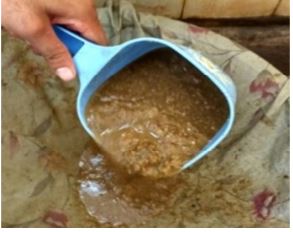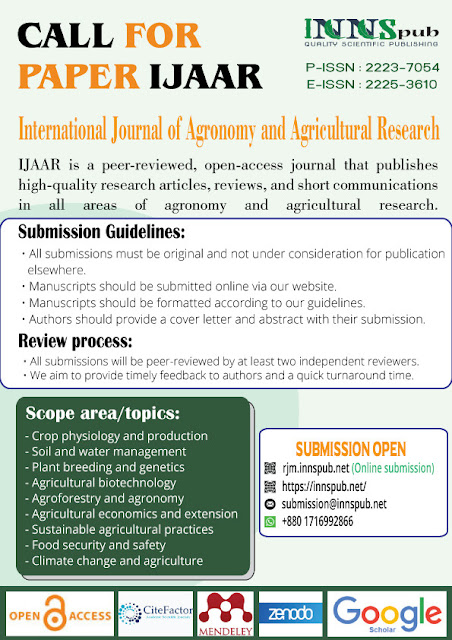 I. Made Sunantra, and Wawan Apzani, from the different institute
of the Indonesia. wrote a research article about, Enhancing Shallot Growth with
Coconut Shell Charcoal and Biocomposts. entitled, The effect of coconut shell
charcoal (CSC) and liquid biocomposts on the growth and yield of shallot
(Allium cepa L.) in dry land. This research paper published by the International Journal of Agronomy and Agricultural Research (IJAAR). an open access scholarly
research journal on Agronomy. under the affiliation of the International
Network For Natural Sciences | NNSpub. an open access
multidisciplinary research journal publisher.
I. Made Sunantra, and Wawan Apzani, from the different institute
of the Indonesia. wrote a research article about, Enhancing Shallot Growth with
Coconut Shell Charcoal and Biocomposts. entitled, The effect of coconut shell
charcoal (CSC) and liquid biocomposts on the growth and yield of shallot
(Allium cepa L.) in dry land. This research paper published by the International Journal of Agronomy and Agricultural Research (IJAAR). an open access scholarly
research journal on Agronomy. under the affiliation of the International
Network For Natural Sciences | NNSpub. an open access
multidisciplinary research journal publisher.Abstract
This research was
conducted to assist farmers in Indonesia in overcoming the problem of scarcity
of fertilizers, expensive fertilizer prices and soil conditions on dry lands.
The method used is an experimental method with experiments in the field. The
activity started in August, 2022 until February 2023. The design used was a
Randomized Block Design (RBD) with factorial experiments. The first factor was
Coconut Shell Charcoal (CSC) with 2 levels, namely T0 (soil without
coconut shell charcoal) and T1 (soil and coconut shell charcoal). The
second factor was liquid biocompost consisting of 5 levels, namely P0 (0
cc/litre water), P1 (1 cc/litre water), P2 (2 cc/litre water), P3 (3 cc/litre
water) and P4 (4 cc/litre water). The results showed that coconut shell
charcoal had a significant effect on shallot growth and yield. This treatment
yielded 2.23 tonnes per hectare while the treatment without the addition of
charcoal yielded 1.80 tonnes per hectare. The results of this study also showed
that liquid biocompost had no significant effect on shallot growth and yield.
However, the 4 cc/litre water liquid biocompost treatment gave better results,
namely 2.43 tonnes per hectare when compared to the treatment without the
addition of liquid biocompost with a yield of 1.80 tonnes per hectare. In
addition, the results of data analysis showed that there was no interaction
between coconut shell charcoal and liquid biocompost.
Read more : Assessing Anti-Inflammatory Properties of Parquetina nigrescens Extracts | InformativeBD
Introduction
Shallots (Allium cepa
L.) are one of the core commodities that can have an impact on inflation in
Indonesia (Permentan, 2022). Shallots have an economic value with a high demand
so that the cultivation of shallots has spread to almost every province in
Indonesia. Anitasari et al. (2019), stated that even though shallots are not a
basic necessity like rice, shallots are always needed as a seasoning for all
Indonesian dishes. Every year the shallot harvested area decreases (BPS, 2020).
This is influenced by the declining productivity of agricultural land as a
result of the application of inorganic fertilizers (Hand et al., 2021), high
doses of fertilization and pesticides that exceed recommended doses which have
an impact on soil structure (Nur and Ismiati, 2007). The decrease in harvested
area can be increased by utilizing dry land which has the potential to become
productive agricultural land (Rahni et al., 2003). However, not all dry land is
suitable for farming. This is due to soil limiting factors such as very steep
slopes or shallow soil solums. Therefore, the management of dry land in each
region will be different depending on the existing limiting factors (Matheus et
al., 2017).
Kata et al. (2020) reported that to improve soil quality in dry land it is necessary to use organic matter. This is in accordance with the opinion of Suntoro (2003) that the application of organic matter can improve the physic, chemical and biological of the soil. Organic fertilizers are divided into two types, namely solid organic fertilizers and liquid organic fertilizers. Solid and liquid fertilizers both have the function of adding nutrients to plants for growth and production.
Planting media is an
external factor needed by plants (Budiyani et al., 2023). A good planting
medium is a medium that is able to provide sufficient amounts of water and
nutrients for plant growth. This can be found in soils with good aeration, good
aggregates, good water holding capacity and optimal root system (Lewu and
Killa, 2020).
This study is aims to utilizing waste that is considered useless as a solution to improve soil conditions in dry land and reduce the use of expensive and rare synthetic chemical fertilizers. In a previous study Apzani et al. (2015) conducted research on solid organic fertilizers and the results were good. However, Apzani et al. 2018a said that liquid fertilizer has the advantage of being easy to carry and nutrients are directly available to plants and can be applied through roots or leaves. Apzani et al. (2015) also have shown that the coconut shell charcoal has no effect on maize growth and yield. So, that is the motivation for investigated further the study about the effect of coconut shell charcoal and liquid biocompost on the growth and yield of shallot (Allium cepa L.) in dry land.
Reference
Anitasari E,
Prihastanti E, Arianto F. 2019. The effect of plasma radiation and goat
manure on the growth of bima brebes red onions. Biolink Journal of Health
Industry Environmental Biology 6(2), 114-125.
Apzani W, Sudantha IM,
Fauzi MT. 2015. Application of Biocompost Stimulator Trichoderma spp. and
Biochar Coconut Shell for Growth and Corn Results (Zea mays L.) on Dry
Land. Jurnal of Agroecotechnology 9(1), 21-35.
Apzani W, Sunantra
IM. 2022. The effect of vermicompost stimulator Trichoderma sp.
and local liquid microorganism of hyacinth on growth and production of Lettuce
(Lactuca sativa L.). International Journal of Agronomy and Agricultural
Research (IJAAR) 20(5), 1-9.
Apzani W, Wardhana AW. 2018a.
Response of Onion (Allium ascalonicum L.) to the Application of
Combination Bioactivator Formula of Coffee Leafs and Hycinth Liquid Organic
Fertilizer Fermented by Trichoderma sp. International Journal of
Agronomy and Agricultural Research (IJAAR) 13(4), 51-63.
Apzani W, Wardhana AW. 2018b.The
Effect of Hyacinth (Eichhornia crassipes) Liquid Organic Fertilizer Fermented
by Trichoderma sp. to the Growth of Onion (Allium ascalonicum L.).
International Journal of Agronomy and Agricultural Research (IJAAR) 13(4), 37-50.
Bertham YH, Aini N,
Murcitro BG, Nusantara AD. 2018. Trial of Four Soybean Varieties in
Coastal Areas Based on Biocompost. Scientific Journal of Biology
Biogenesis 6(1), 36-42.
BPS. 2020.
Productivity of Shallots According to Province 2015-2019. Central Statistics
Agency 2020. http:// www.pertanian.go.id/Data5tahun/Horti ATAP
2020/Produktivitas %20 Bawang % 20 Merah. pdf. [June 5, 2022]
Budiyani NK, Apriastuti
NPE, Dwipradnyana IMM. 2023. Growth and Yield Responses of Eggplant Plants
to the Use of Growing Media and Dosages of Organic Fertilizers. Journal Ganec
Swara 17(1), 278-282.
Gardner FP, Brent P,
Roger L, Mitchell. 1991. Physiology of Aquaculture Plants. Translated by
H. Susilo. University of Indonesia Press. Jakarta.
Hand MJ, Nassourou M,
Nono GV, Taffouo VD, Youmbi E. 2021. Organic and inorganic nutrient
sources influeced growth, flowering, fruition, fruit relative water content and
yield of pepper (Capsicum annuum L.) cultivars under salinity in coastal
region of Cameroon. IJAAR 18(5), 33-51.
Hayati E, Mahmud, Riza
F. 2012. Effect of Types of Organic Fertilizers on the Growth and Yields
of Chili (Capsicum annum L.). Floratek Journal 7(2), 173-181.
Kata A, Osmet, Analia
D. 2020. Analysis of Soybean Commodity Competitiveness on Dry Land in Tebo
Regency. Agri Science Journal 4(1), 48-59.
Khan AA, Jilani G,
Akhtar MS, Islam M, Naqvi SMS. 2015. Potential of phosphorus solubilizing
microorganisms to transform soil P fractions in sub-tropical Udic Haplustalfs
soil. Journal of Biodiversity and Environmental Sciences (JBES) 7(3), 220-227.
Lewu LD, Killa
YM. 2020. Rooting Variation, Canopy and Correlation on Soybean Yield at
Various Combinations of Watering Intervals and Doses of Organic Matter. Journal
of sustainable agriculture 8(3), 114-121.
Lingga P, Marsono. 2005.
Instructions for using fertilizer. Penebar Swadaya. Jakarta.
Malik A, Gul S, Buriro
AH, Kakar H, Ziad T. 2022. Particle size of co-composted biochar:
Influence on growth performance of lettuce and concentration of bioavailable
soil nutrients under salinity stress conditions. International Journal of
Biosciences (IJB) 20(3), 16-28.
Matheus R, Moy LM,
Kantur D. 2017. Utilization of corn stover and pruned Gliricidia sepium
biochars as soil conditioner to improve carbon sequestration, soil nutrients
and maize production at dry land farming in Timor, Indonesia. International
Journal of Agronomy and Agricultural Research (IJAAR) 10(4), 1-8.
Meiyana RY, Salamiah,
Soedijo S, Pramudi MI. 2021. Diversity of Soil Surface Arthropods on
Shallots Plants (Allium ascalonicum L.) Applied by Several Botanical
Pesticides In Peatlands. International Journal of Biosciences (IJB) 19(3), 73-82.
Multazam. 2012.
Dosage Test of Biochar and Nitrogen Fertilizer on Water Use Efficiency and
Improvement of Soil Physical Properties and Corn Growth in Sandy Soils of North
Lombok. Thesis Master’s Program in Dryland Resource Management, Postgraduate
Program, University of Mataram. Mataram.
Nur S, Ismiyati. 2007.
Effect of Manure Dosage and Time of Application of Trichoderma spp.
Antagonistic Fungi. as Control of Fusarium Wilt Disease on the Growth and Yield
of Shallots. Journal of Agrijati 6(1), 14-19
Permentan. 2022.
Regulation of the Minister of Agriculture of the Republic of Indonesia Number
10 of 2022 concerning Procedures for Determining Allocations and Highest Retail
Prices of Subsidized Fertilizers in the Agricultural Sector. State Gazette of
the Republic of Indonesia. http:// peraturan. bpk.go.id. [Downloaded on March
08, 2023].
Rahni NM, Wijayanto T,
Safuan LO, Tufaila M, Zani M. 2019. Development and application of
secondary vegetation-based biotechnology bokasi plus to increase soybean
production on marginal dry land. International Journal of Biosciences (IJB) 15(3), 307-313.
Rizwan M, Ahmed K,
Sarfraz M, Nawaz MQ, Qadir G, Usaman M, Ijaz MW. 2018. Managing Sesbania decomposition
with urea and different tillage techniques in salt affected soil. International
Journal of Biosciences (IJB) 12(6), 258-268.
Rukmana. 1994.
Shallots: Cultivation and Postharvest Processing. Kanisius. Yogyakarta
Sa’adah S. 2007.
Onion Cultivation. Azka Mulia Media. Jakarta.
Salisbury FB, Ross
CW. 1995. Fisiology of Plants Volume 1. Plant Development and Physiology
(Translation DR Lukman and Sumaryono). Bandung Institute of Technology.
Bandung.
Situmeang YP. 2020.
Bamboo Biochar Improves Soil Quality and Corn Yield. Scopindo Media Pustaka.
Surabaya.
Sonia T. 2014. The
Effect of Application of Fresh Organic Matter and Biochar on the Availability
of P in Soil in the Dry Land of South Malang. Journal of Land and Land
Resources 1(1), 89-98.
Suntoro. 2003. The
Role of Organic Material on Soil Fertility and Its Management Efforts.
Inaugural Speech Professor of Soil Fertility Science, Sebelas Maret University,
Indonesia.
Susilawati, Budhisurya
E, Anggono RCW, Simanjuntak B. 2016. Soil Fertility Analysis With Soil
Microorganism Indicators In Various Land Use Systems In Plateau Dieng. Journal
Agric 25(1), 64-72.
Tarigan, Aulia ALB,
Riniarti, Melya, Prasetia, Hendra, Hidayat, Wahyu, Niswati, Ainin, Banuwa,
Sukri I, Hasanudin, Udin. 2021. Effect of Biochar on Rhizobium Symbiosis
and Sea Sengon Root (Paraserianthes falcataria) in Growing Media. Journal of
People, Forests and Environment 1(1), 11-20.







..JPG)




%20in%20full.JPG)


0 comments:
Post a Comment